Exchange management is a headache
Countless articles, blog posts and forum topics in the Internet support the above statement. Web searches yield a myriad of various tips and best practices on how to streamline the process and make it less expensive. With all the vast amounts of information available, the problem is still there and desperately needs a strong and effective solution.
Why is there so much talk and fuss about Exchange management? The answer is straightforward: because it is expensive as it involves a lot of manual work by skilled technicians. Consider the following. When a new employee comes in, someone needs to create and configure a new mailbox for the employee. This requires knowledge of how to pick a mailbox database, which mailbox features to enable for this particular user, which mailbox policies to assign, etc. When an employee is relocated to a different city, promoted, or transferred to another department, somebody has to move their mailbox to another database, adjust mailbox rights, change mail flow settings, etc. When an employee goes on sick leave, somebody must set the Auto-Reply message for the user, configure email forwarding, put the mailbox on retention hold, etc. When an employee leaves or retires, their mailbox must be properly deprovisioned, which is a complex task that requires multiple steps to complete.
What does all this mean? It means that somebody has to learn and consistently follow a rigorous set of guidelines and policies for Exchange management. Not only is it ineffective and a huge waste of human resources, it also leaves too much room for human error - the root cause of downtime and out-of-compliance issues.
EXCHANGE MANAGEMENT IS A PAIN: stop doing it!
Wouldn't it is great to delegate those routine Exchange management tasks and forget about it for good? If you are reading this, most likely you are dreaming about such an opportunity! The good news is you are in the right place, as Adaxes is ready to do all the hard job for you accurately, timely and in accordance with strict policies and procedures. Read on how you can leverage Adaxes to completely automate Exchange management and administration.
Automating Exchange Management
With Adaxes, you can completely automate the process of provisioning and management of mailboxes, distribution lists and mail-enabled recipients in Exchange 2003, 2007, 2010, 2013 and 2016.
Automatic Mailbox Creation
It all starts when something happens in the real world. When a new employee is hired, a user account is created in Active Directory. This triggers Adaxes to automatically create an Exchange mailbox for the newcomer and modify mailbox parameters based on the data entered during account creation.
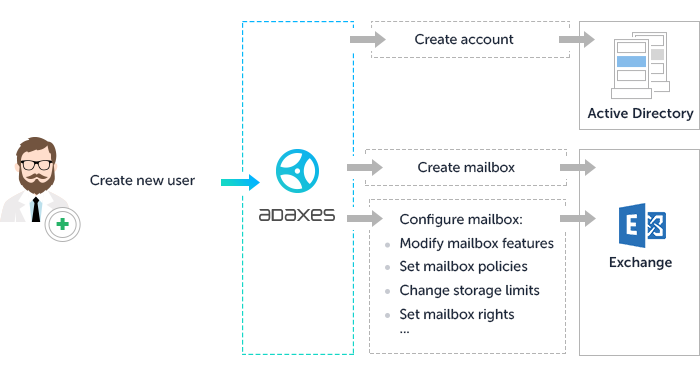
By establishing rules for mailbox provisioning, you can define when to create a mailbox, how to generate the alias, and tell Adaxes how to pick a database.
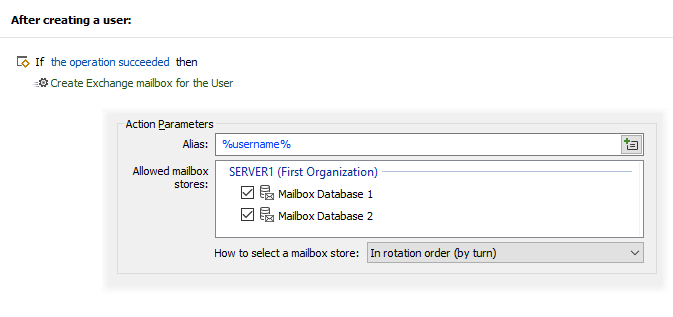
To uniformly distribute mailboxes among databases you can configure Adaxes to choose a database with the least number of mailboxes, use the round-robin method, or pick a database based on, for example, the office location of the user.
You'll definitely want Adaxes to also configure newly created mailboxes. No problem. Adaxes can automatically enable or disable mailbox features, like Archiving and Unified Messaging, set mailbox policies, modify mailbox limits and quotas, adjust delivery options, set mailbox rights, and much more!
Automated Mailbox Management
When a user account is updated, following predefined rules Adaxes can automatically make appropriate changes in Exchange. Without any user interaction.
For example, when an employee moves to another office, this usually requires changes to multiple applications, including Active Directory and Exchange. With Adaxes, the whole process flows from a centralised web console, with only one change triggering a chain of other changes.
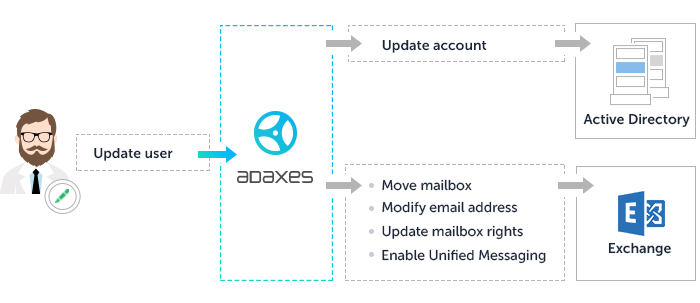
In other words, it is enough to update the Office property in Active Directory, Adaxes will do the rest of the job automatically. For example, it can move the mailbox to another database, update mailbox properties, add the user to a distribution list associated with the new office, etc.

Automated Mailbox Deprovisioning
When an employee leaves, all resources associated with them, must be deprovisioned. From a process standpoint, deprovisioning is a way more complicated than simple deletion, and there are plenty of reasons for that. In most cases, you don't want to delete user accounts, mailboxes, and so on immediately upon the departure of an employee. Instead, you want to disable the account, hide the mailbox from Exchange address lists, forward incoming mail to the manager, move the mailbox to a database dedicated for terminated mailboxes, etc.
In this regard, Adaxes also can offer something that makes your life easier, and this something is Custom Commands. Using Custom Commands, you can turn any complex, multi-step operation into a one-click action.
Adaxes, out of the box, already contains a Custom Command called Deprovision that is configured to perform typical deprovisioning actions, and can be customised to meet your own needs.
All one need to do to deprovision an employee is a mouse click!
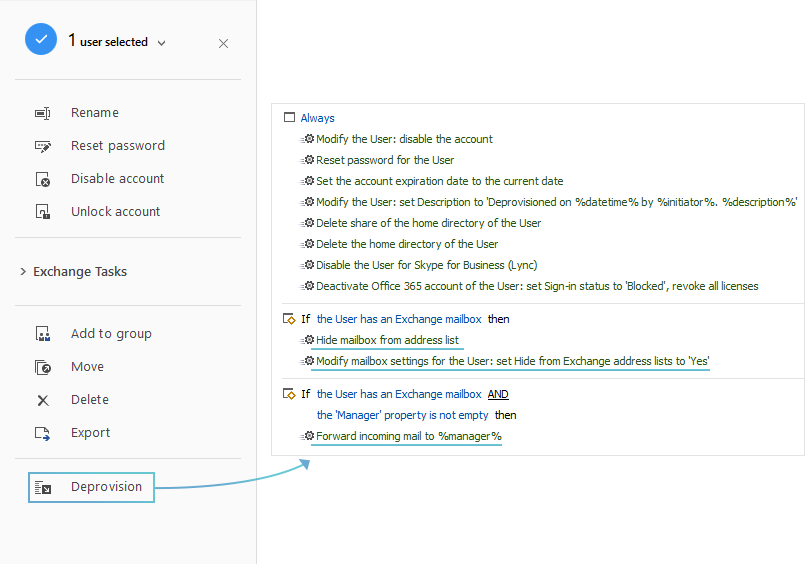
Exchange Management via Web Interface
While automation is perfect for repetitive tasks, sometimes human interaction is still needed, for example, to handle support cases. This requires a modern, efficient and reliable management tool.
An easy-to-use web-based interface provided by Adaxes includes an array of convenient features that allow administrators, managers, help desk personnel, or anyone else to manage Exchange mailboxes, distribution lists, and mail-enabled contacts via simple and intuitive web-based console.
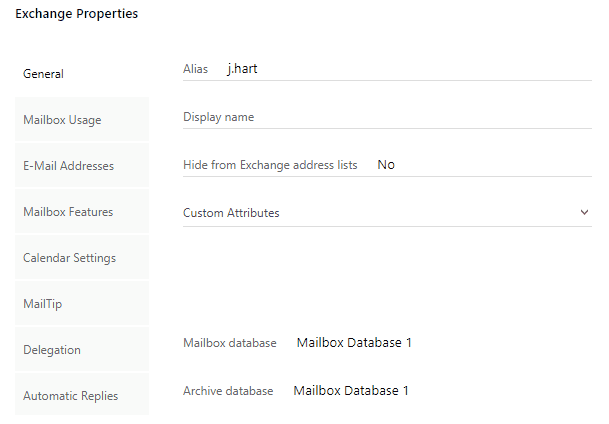
It is a must requirement for any good management tool to be flexible enough to allow users to see only what they need to see and to do only what they need to do. A good user interface must be clear and simple. It is particularly important if you delegate Exchange management tasks to non-technical or less qualified people.
If the user interface is overloaded with features and options that users don't really need, be sure, one day somebody will click on the wrong button and break something.
Adaxes Web Interface is built with customisation in mind. It gives you the ability to customise any view and input form, define which operations are available for users, customise every operation to address your unique needs and goals.
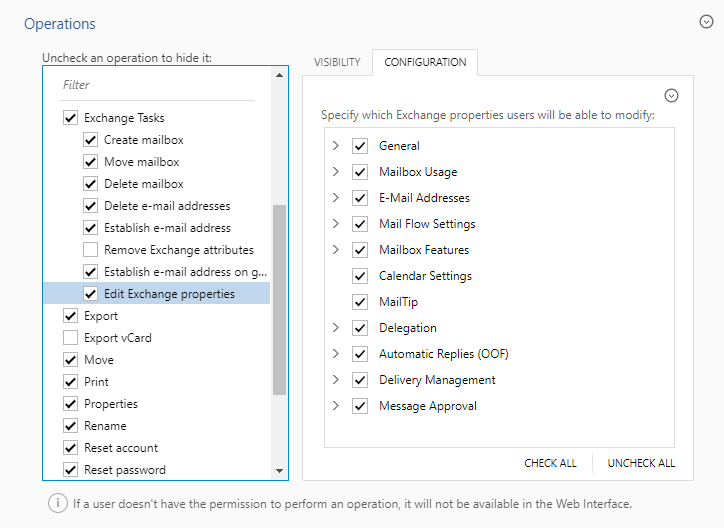
Delegating Exchange Tasks
The ability to granularly delegate permissions for Exchange management tasks is essential. You will be happy to know how easy it is to control the scope of delegatee's administrative power with the Role-Based Access Control model implemented in Adaxes.
For each Security Role, you can explicitly define the minimum permissions required for role users to accomplish their duties, without providing unnecessary access. For example, you can allow your Help Desk to only update Auto-Reply messages, and enable, disable and configure Unified Messaging services and Archiving
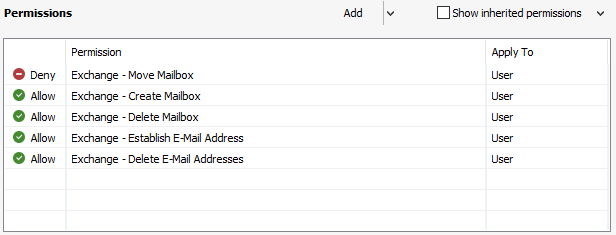
Exchange Management is Simple!
At the beginning, this article claimed that Exchange management was difficult. Now, when you are reading these lines, you may probably feel a bit confused. Sorry. In fact, Exchange management is simple when you use the right tools. And Adaxes is the key to success.
Other Features
Active Directory Management
Adaxes features a rule-based platform for Active Directory, Exchange and Office 365 automation, provides an enhanced web-based management environment, gives you a role-based access control model for delegating privileges, adds security with approval-based workflow, allows enforcing corporate data standards and much more.
More InfoActive Directory Automation
Adaxes provides rule-based automation for Active Directory, Exchange and Office 365. It allows executing sets of operations that are governed by if/else conditions before or after certain events in AD. So, for example, after the department of a user is changed, Adaxes can then automatically update the user’s group membership and send an email notification to the user’s manager, following the rules you define.
More InfoActive Directory Provisioning
Using condition-based rules you can automate the entire user provisioning process. Once a new user account is created in Active Directory, Adaxes will automatically execute the rest of onboarding procedures for you: moving the user account to a correct OU, adding it to necessary groups, creating and configuring an Exchange mailbox, assigning Office 365 licences, enabling the user for Skype for Business, creating and sharing a home folder, sending a welcome email, etc. Similarly to that, you can also automate all operations associated with user updates. Finally, when a user is terminated, Adaxes can automatically execute all the provisioning operations in reverse, ensuring instant and errorless offboarding.
More InfoWeb Interface for Active Directory
Adaxes Web Interface enables Active Directory management via a standard web browser. It features a modern responsive design, so users can access it on their laptops, tablets, phones or any other devices. You can set up different Web Interfaces specifically tuned for the needs of different job roles, like administrators, help desk, HR, managers, and others, giving them a clean and intuitive way to access the tasks they need. Adaxes Web Interface also incorporates Exchange and Office 365 management, so users get a single console without the need to learn and use multiple tools for their day-to-day routines.
More InfoWeb Interface Customisation
The Adaxes Web Interface is fully customisable, so you can configure it to have the exact views, forms, and operations that each user needs. For example, administrators can have a full set of management activities in Active Directory, Exchange and Office 365 across the entire environment, whereas managers can be set to view just their subordinates and only be able to update their group membership, assign Office 365 licences and change certain AD properties.
More InfoActive Directory Self Service
Adaxes Web Interface can act as a self-service portal for regular users. You can granularly specify, which operations they have access to, like updating their personal info, changing their own password, searching Active Directory, managing own group membership, updating Office 365 licences, etc.
More InfoActive Directory Password Self-Service
Adaxes Password Self-Service allows users to reset forgotten passwords and unlock accounts by themselves. To do that they need to go through a simple identity verification procedure that may involve answering security questions, SMS verification, using authenticator apps like Google Authenticator, Authy and others. A self-password reset can be accessed from the Windows logon screen, Adaxes Web Interface or it can be integrated into your own portal.
More InfoExchange Management and Automation
Adaxes automates Exchange mailbox management both on-premises and in Office 365. For example, after creating a new user account in Active Directory, Adaxes can automatically create an Exchange mailbox for the user. The database distribution of mailboxes can be done based on the first letter of the users’ surname, least number of mailboxes in the DB, the round-robin method, etc. Adaxes can then configure the mailbox, e.g. modify storage quotas or enable mailbox features like Unified Messaging or Archiving.
More InfoOffice 365 Automation and management
Adaxes can automatically assign and revoke Office 365 licences using condition-based rules. For example, when a new user is created in Active Directory, Adaxes can activate an account in Office 365 for the user and assign the necessary O365 licences according to the rules you define. Different licences can be assigned to different users based on their job title, department, location, etc.
More InfoActive Directory Role-Based Security
Adaxes introduces Role-Based Access Control for Active Directory, Exchange and Office 365. In a role-based delegation model, instead of assigning permissions to users, they are assigned to roles that correspond to actual job functions. So, when you need to change privileges for all users with the same job function, all you need to do is modify the permissions of the associated role. Assigning roles to users is done in a centralised manner, allowing you to easily control, who can do what and where. With role-based delegation, you can granularly specify, which parts of Active Directory are visible to users. For example, you can allow certain users to only view AD objects located in their own OU, while hiding the rest of the Active Directory structure from them.
More InfoApproval-Based Workflow
Adaxes allows you to add an approval step to practically any operation in Active Directory, Exchange and Office 365. For example, you can delegate user creation to HR, but after they fill in the form and click Create, Adaxes can suspend the operation and only proceed once a member of IT staff reviews and approves it. For more complex and security-sensitive scenarios, you can set up multi-level approvals. Such an approach allows delegating more tasks to lower level staff without taking the risk of losing control over them.
More InfoActive Directory Reports
Adaxes comes with reporting capabilities, allowing you to monitor and analyse what’s going on in your environment. Out of the box, you get more than 200 reports, which should cover the majority of your requirements. For more demanding scenarios Adaxes also provides various ways to create custom reports, including using your own scripts. It enables you to create reports of practically any complexity that can be specific to your organisation's needs. To deliver reports to users Adaxes supports centralised scheduling and also provides a self-scheduling option, allowing users to choose by themselves, which reports they want to receive and when.
More InfoCustom Commands for Active Directory
With Custom Commands users can launch complex multi-step operations in one go. For example, if you need to send a user on vacation, you can do it with just one click in the Web Interface. The operation can include steps like disabling the user account, adding it to a corresponding group, sending a notification to the user’s manager, etc. Such an approach allows you to delegate complicated tasks to users and not worry that they will miss a step or do something wrong. Besides, you don’t over-privilege them, as you only give out permissions to execute the Custom Command as a whole, not the individual steps it consists of. Administrators can also use Custom Commands in their day-to-day routines to make the management process simpler and accomplish the same results with a lot fewer clicks.
More InfoScheduled Tasks for Active Directory Management
Adaxes allows you to automate various routine management tasks by scheduling them. For example, it can automatically de-provision inactive accounts in AD, allocate users to necessary groups, maintain OU structure, etc. You can also schedule tasks like importing new users from CSV. Automating such a sensitive operation doesn’t mean that you need to sacrifice any control, as you can add an approval step to it. This way users will be created in AD only after a member of IT staff reviews and approves the operation. You can also use scheduled tasks to send various notifications to users, like reminders about their password or account expiration.
More InfoActive Directory Delegation
Active Directory management involves many different operations that require administrative privileges granted by default to AD administrators only. Though operations like password reset or account unlock are pretty simple, they take a lot of time of highly-skilled IT staff, not allowing them to focus on more complex and important issues. Active Directory delegation helps you optimise the productivity of the IT department by letting non-administrative users (e.g. department managers or Help Desk operators) perform certain administrative activities in Active Directory.
More Info

